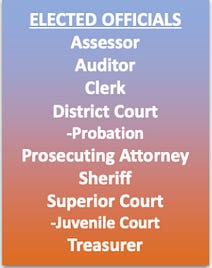Who oversees whom?
Last Wednesday’s post, “Spokane County Commissioners” discussed the major changes facing us this year as the Spokane County Board of Commissioners expands from three to five members and the manner of their election crucially changes. The top two district-based Commissioner candidates moving on to the November General Election will no longer be elected by a county-wide vote, but instead only by the voters in their district of residence. If the voters are paying attention, the result should be better accountability to the electorate.
County commissioners in Washington State wield a great deal of power. A three (or even a five) member county commission sits at a bottleneck in governance: county commissioners comprise both the executive and legislative branches of government. Thus, on a per person basis, county commissioners are in a position of leveraged power—power they often seem happy to wield mostly out of the awareness of the voters who elect them.
The Spokane County Commissioners oversee a large bureaucracy illustrated in this “County Organizational Chart”:

The “Board of County Commissioners” is in control of a County CEO, seven “Directors”, a County Engineer, and no fewer than 30 county departments.
But, nestled in a postage stamp in the upper right corner of that chart is something well worth noting:

Why are these elected offices depicted off to the side of the Organizational Chart? After all, we learned in high school that in the federal government functions like those of the assessor, auditor, treasurer, prosecutor, and sheriff would fall under the executive branch. The individuals administering all these functions are be appointed by the executive (President) with the “advice and consent” of the Senate. Judges at the federal level are similarly appointed. (The functions analogous to those of the County Clerk—primarily record-keeping and interfacing with the public for the County’s Superior Court system—might also fall at the federal level more under the judicial than the executive branch.)
Here’s the key: All of the elected positions and functions contained in that postage stamp box in the Organizational Chart operate primarily under state law, not at the direction of County Commissioners. When, for example, our Spokane County Auditor, Vicky Dalton, manages elections, property record-keeping, and vehicle licensing and registration she is operating under the Revised Code of Washington (RCW) and the Washington Administrative Code (WAC) established at the State level. She performs detailed executive, managerial functions within checks and balances established by the state. Of course all these county elected officials interact with the County Commissioners in their work and to some degree around their budgets, but the rules under which they function are state rules, not the direct product of the executive/legislative function of the County Commissioners.
We ought to think of all these non-commissioner, county-level elected officials listed on the postage stamp to be, in many ways, independent of the County Commissioners, while the Commissioners control the myriad of other important functions seen on the Chart.
This year’s elections, an even-numbered, non-presidential year, have all these county level officials on the ballot.
The August 2 Primary Election for Spokane County features:
Spokane County prosecutor: Larry Haskell (R), Stephanie Olsen (R), Stefanie Collins (R), Deb Conklin (nonpartisan)
Spokane County sheriff: John Nowels (R), Michael Zollars (R), Wade Nelson (R)
Spokane County auditor: Vicky Dalton (D), Bob McCaslin (R)
Spokane County treasurer: Michael Baumgartner (R)
Spokane County assessor: Tom Konis (R)
Spokane County clerk: Tim Fitzgerald (R)
Eight Spokane County District Court Judgeships, only two of which are contested (two candidates for each of two positions), will appear on the November General Election ballot, but not on the August Primary ballot. (I understand that a District Court judge race would appear in the primary ballot if there were more than two candidates for one of the seats OR if these were partisan races.)
Each of contested positions for auditor, prosecutor, and sheriff deserve careful treatment in later posts, but for now…
Keep to the high ground,
Jerry